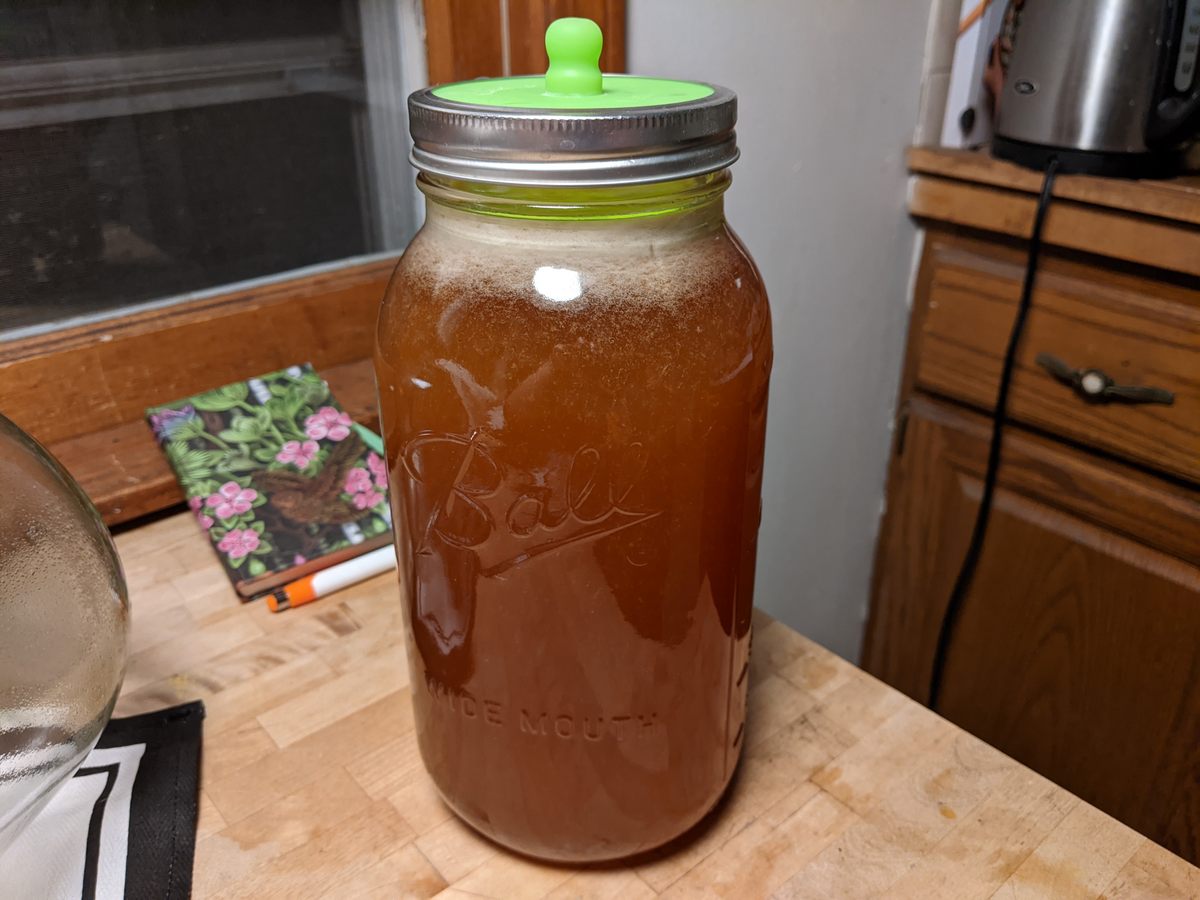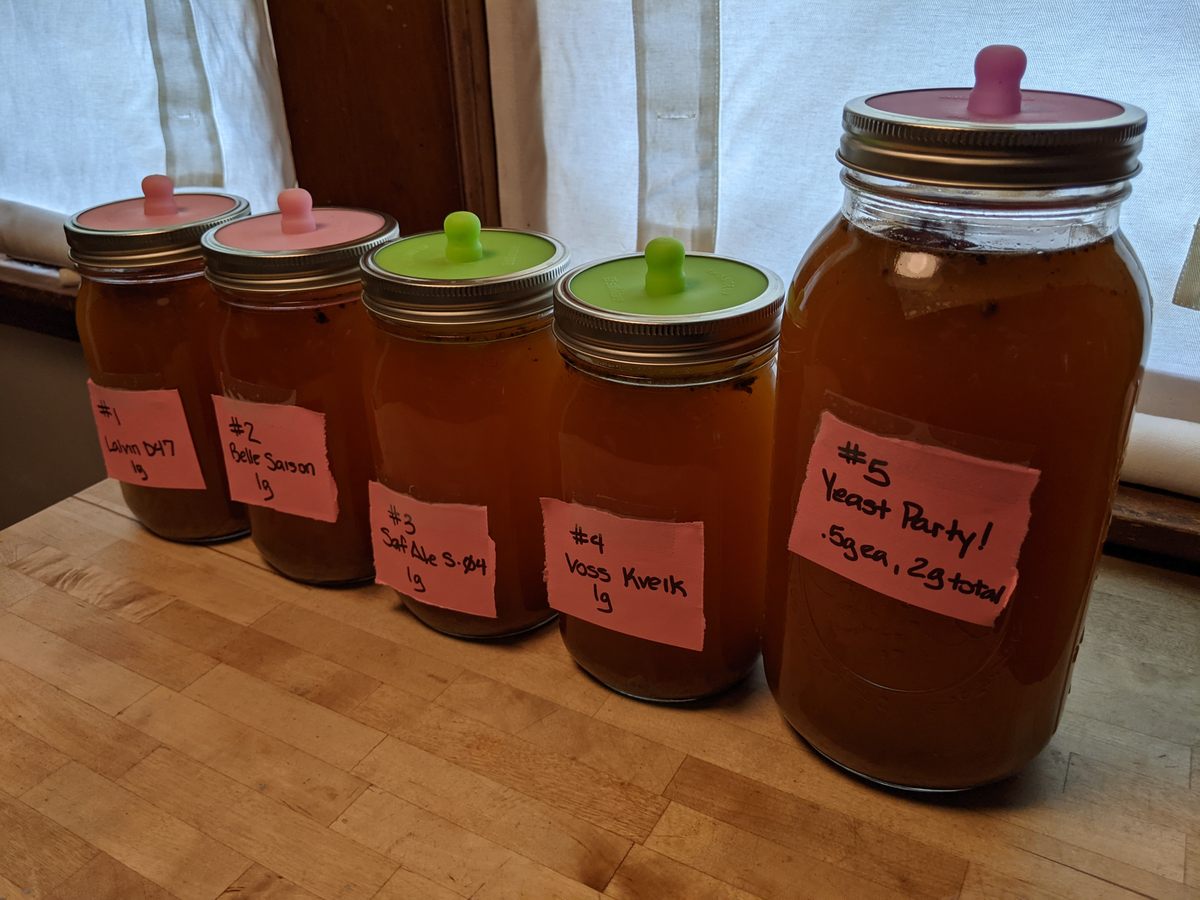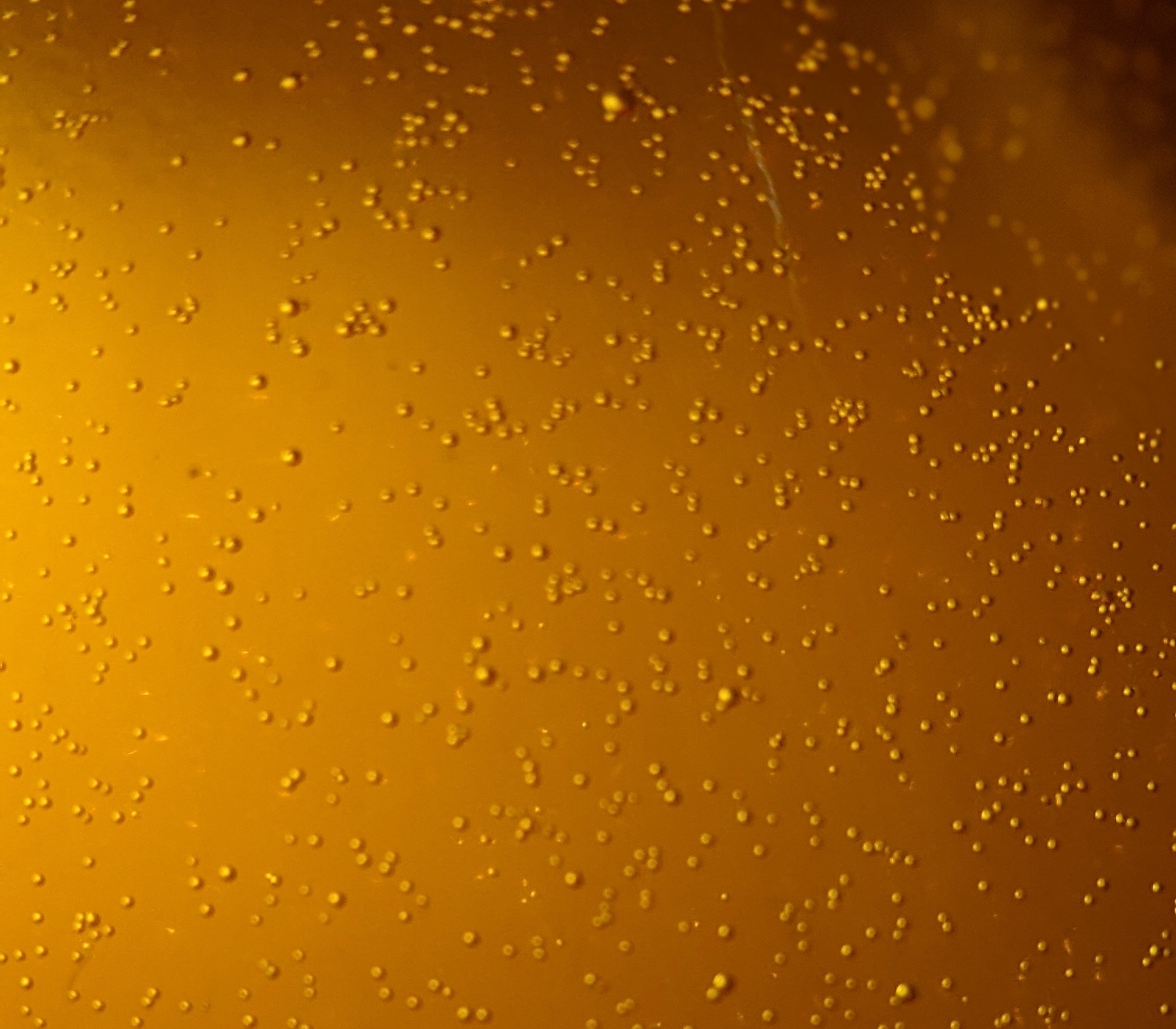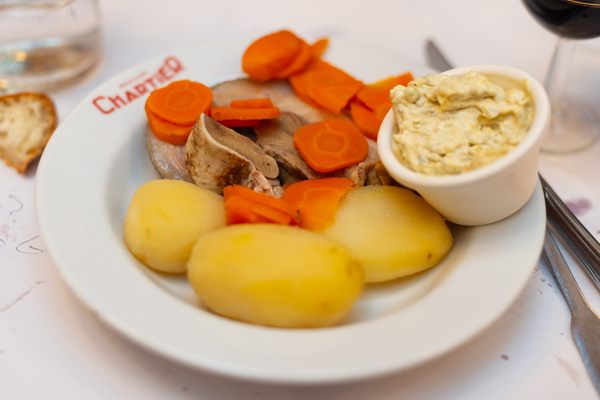

The Quest to Recreate a Lost and ‘Terrifying’ Medieval Mead
Bochet vanished for centuries, but meadmakers are bringing it back—at least in spirit.
It starts with a cauldron, an open flame, and a good measure of raw honey. Then—double, double, toil and trouble—stir constantly until the honey spits black steam at you. Add water and stand back as it erupts, volcano-like. Throw in some yeast and spices and, after it ages a bit, behold: bochet, a mysterious and lost style of mead.
My path to recreate this ancient and mysterious beverage would take me on a deep dive into the nitty-gritty of medieval yeast strains, and turn my tiny kitchen into a mad scientist’s lab. It would have me digging through scant archival records about obscure systems of measurement in 14th century France. This experiment would require my biggest stockpot—and nerves of steel.
“Caramelizing honey is kind of terrifying,” says Ontario microbiologist Bryan Heit, the brains behind popular homebrewing reference site Sui Generis Brewing. While Heit experiments mostly with beer, particularly traditional styles, he’s been intrigued by bochet for years.
“It truly is a lost style. It’s not a historical style that has survived into the modern era,” says Heit. “It’s literally something that disappeared.”

Bochet is mentioned, briefly, in French texts as early as 1292, according to research by independent scholar Susan Verberg, published in 2020 in ExArc Journal. The first and only complete recipe for the drink—and the primary source for modern recreations—turns up in 1393, in what might be considered a manual of mansplaining.
An anonymous French writer penned an exhaustive guide to etiquette, moral conduct, and the practical concerns of a young bride, from choosing servants to throwing feasts: Le Ménagier de Paris (The Good Wife’s Guide). “It’s a ridiculous book,” says Verberg. “It’s micromanagement. I would not have wanted to be his wife.” The book was known mostly in medievalist circles until 2009, when it was fully translated into modern English for the first time. And there, in between reminders of the need for wifely submission and tips on keeping fleas out of the bedclothes, was a curious recipe for something called bochet.
The recipe called for water and honey, plus “brewer’s yeast” and an assortment of spices, including ginger and cloves. That’s standard fare for medieval mead, as were the steps describing fermentation. But the very first few steps were unique: “Put it in a cauldron on the fire to boil” and stir until the honey blisters and bursts, “giving off a little blackish steam.” Unlike any other mead, which is based on raw or gently warmed honey, bochet requires the honey to be caramelized.
A preserved recipe for an extinct beverage is a rarity, and its unique method tantalized historic reenactors and homebrewers alike, including myself. While I’ve made small-batch meads in the past, they have all been based on modern ratios, and none involved a cauldron. Commercial meadmakers have been particularly intrigued by the idea of caramelization: The process offers new possibilities, unlocking “all those roasty, toasty, nutty flavors,” says Jen Otis of KVLT Mead in Tacoma.
Finding a vessel that’s big enough can be a challenge, however, particularly for commercial-scale bochet. “Honey can double, possibly triple, in volume when heated to certain temperatures. For safety, the vessel would have to be four times larger than what you think you would need,” says Ricky Klein, head meadmaker at Vermont’s Groennfell Meadery. He has made small-scale, experimental bochets, and has some words of wisdom. “There are two things I will always say about a bochet. One is, you have never been scalded like getting boiling honey on your skin. It is a second-degree burn, immediately. It can be a very, very nasty burn,” says Klein. “The second thing is, what I just said.”
For some homebrewers, the danger of recreating bochet may be the very thing that attracts them to it. “People who like rollercoasters and jumping off cliffs like bochet,” says Verberg with a laugh. “You can make a sugar volcano that will explode, violently.”
To recreate bochet—at least the version detailed in Le Ménagier, the only full recipe to survive—I started at the source. Most modern interpretations call for a ratio of 3–4 pounds of honey per gallon of water. Le Ménagier calls for one quart of honey (about 3 pounds) per septier, an antiquated measurement that varied from one region to the next. Digging through the scant historical records available online, I found that, in Paris, a septier equaled about four gallons. Modern versions use four times the honey, or more, as the 1393 version.

Then there’s the honey itself. “Honey as diverse as what they had access to then, when monoculture was not a thing, was very different,” says Verberg. Harvesting techniques have also changed: Today, commercial beekeepers and most hobbyists use extractors that pull honey out of the wax comb through centrifugal force. Back in medieval times, says Verberg, “They weren’t extracting the honey, they were crushing it.” In addition to bits of wax, the medieval meadmakers also had pollen and the occasional squished bee in their raw material—components missing from modern honey that would have added more flavor. For example, propolis, a sticky, antibacterial compound that bees produce for colony health, has a zingy taste, and beeswax itself can impart a fuller mouthfeel. “I found that that contamination is really good, and we’re really missing it,” says Verberg, a beekeeper who has made traditional meads.
As a beekeeper, I have access to raw honey produced from a wide range of flowers. Instead of using honey I’d extracted and strained the modern way, however, I crushed some comb taken from a colony that had unfortunately not survived winter—the bees’ lasting legacy would be to provide honey close to what was available in the 14th century, including the occasional stray leg or wing.

To avoid the chlorine, fluoride, and other additives found in modern tap water, I opted for distilled water. The spices called for in the Le Ménagier recipe include supermarket staples such as ginger and cloves, but also long pepper and grains of paradise. I used a pepper blend that included grains of paradise and added some cardamom, which, combined with black pepper, is often cited as a long pepper substitute.
The toughest thing to recreate from 1393 is the yeast, which, next to the caramelization of the honey, would have had the most impact on a bochet’s taste. Unlike medieval yeasts, which were not cultured in clean labs, modern commercial yeasts are typically single strains bred for reliability and characteristics specific to their use: A commercial wine yeast will perform very differently, and create different flavors, than bread yeast. While most modern bochet recipes use a wine or champagne-style yeast, Le Ménagier called for beer (or, in a pinch, bread) yeast. Heit, Verberg, and others who’ve dabbled in historic bochet suggested trying everything from English-style ale yeast to Norwegian Kveik, now commercially available after being used by farmhouse brewers “for over a thousand years,” says Heit. “It’s not the yeast historical to the France area, but it might be closer to what they had.”
To get as close as possible to a vintage 1393 bochet without investing in special equipment, and to learn how different yeasts might affect the final product, there seemed only one option: a controlled trial. I adapted Le Ménagier’s recipe for a smaller batch and then divided that into six micro-batches; only the yeast would be different.

I bought a few commercial ale-brewing strains other meadmakers had suggested, as well as a dry white wine variety often called for in online modern bochet recipes. I also reserved a little of the caramelized honey for a wild-ferment bochet: I would collect whatever yeast was in my environment, similar to how sourdough bread is traditionally made.
I also added a few organic raisins, which would help the yeast get started. The concept is the same as adding a lab-derived yeast nutrient powder, called for in many modern bochet recipes; the difference here is that medieval meadmakers would have had access to raisins or other dried fruit.
With a big enough pot, caramelization was a safe and stress-free process—though, full disclosure, I’ve worked as a pastry chef and this was not my first time to the sugar volcano rodeo. Once measured into their glass jars, each batch bubbled away happily for a month before being strained and moved into new, clean containers for the duration of fermentation.
While transferring them to new jars, I sampled the month-old batches. They were thinner in body and less sweet than other meads I’ve made, thanks to the lower ratio of honey-to-water. The different yeasts gave each micro-batch its own distinct character, from a bone-dry, astringent drink made with white wine yeast to the sweeter and smoother concoction that used English ale-style yeast. The Kveik’s dominant notes were bitter and medicinal—perhaps appropriate, since Verberg’s research suggests bochet may have been drunk to balance one’s humors. The wild yeast strain was milder overall, similar to the English ale–style but not as sweet.

“You have to do a decent amount of conjecture as you try to get close to what they did,” says Jereme Zimmerman, author of Make Mead Like a Viking. “In some cases, you really try to recreate what they did historically, and it doesn’t come out that great.”
The experiment was not a disappointment. Unlike many beers, meads are generally meant to be aged, and most don’t reach their potential for a year. So I’ll bottle these batches when they stop bubbling, and set them aside to see what develops. All of them taste of caramel, honey, and history.
Bochet
Adapted from Le Ménagier de Paris, 1393
Yields 1 gallon
Ingredients
1 pint (24 ounces by weight) good quality, raw honey, preferably local and multi-source, such as wildflower honey
1 gallon plus 1 pint water, distilled or spring (do not use tap water)
4 grams (about 1 rounded teaspoon) of commercial wine, beer, or bread dry yeast, either single-strain or a combination per preference (do not use rapid-rise bread yeast)
1 ounce (28 grams or about 3 tablespoons) organic raisins, chopped
6 grams (about one tablespoon) fresh ginger, skin on, chopped
4 cloves, whole
20 green cardamom pods, lightly crushed
8 grams (about one tablespoon) whole black peppercorns, or peppercorn blend (preferably including grains of paradise), lightly crushed
Step 1
The first step toward making bochet is the most important and potentially most dangerous: Caramelize the honey. Boiling honey, or any sugar, can be messy and, if done improperly, can cause severe burns (unlike water, boiling sugar adheres to the skin). Choose a tall pot at least three times larger than the volume of the honey.
Place the pot on stove and add one gallon of the water. Make a mental note of the waterline on the pot for later reference (if using a pot that has quarts and gallons marked on the side, skip this step). Pour the water out into another container but keep it within easy reach. Wipe the pot dry.
Turn the burner on medium-high heat and add the honey to the pot. Monitor the honey closely; when it starts to bubble, begin stirring it gently with a long-handled stainless steel or wood spoon, making sure that the spoon touches the bottom of the pot. Avoid sloshing or splattering honey up the sides of the pot, where it can burn. The edges of the honey will begin to darken when caramelization starts; the bubbling will then slow and the honey will take on a foamy appearance. The bubbles will start to pop and emit steam; to avoid scalding your eyeballs, do not lean over pot. If the honey begins to swell, lower the heat but do not stop stirring.
As the honey continues to darken, you can test its color by letting a drop of it fall from the spoon onto a plate, where it will quickly harden. Do not stick your finger in the boiling honey. Do not touch the drop of honey, which will remain hot for several minutes.
When the honey is a deep mahogany color (after 20–30 minutes, depending on the type of pot and burner setting), turn off the burner. Do not lean over the pot. Slowly pour in about two cups of the water while continuing to stir. The caramelized honey will swell dramatically and sputter intensely for a few seconds, shooting up a lot of steam. If you have chosen your pot wisely and are not leaning over it, you’ll be fine.
Continue stirring and gradually add the remaining water. Bring to a boil and reduce to the level noted earlier (or to the gallon mark on the inside of the pot). Turn off the burner and remove the pot from the heat. Let it cool to room temperature, which may take a few hours or even overnight. Do not refrigerate, since fermentation will only occur at or slightly above room temperature.
Step 2
While the caramelized honey syrup is cooling to room temperature, wash and sanitize the fermentation vessel and lid. To make a gallon batch of bochet without investing in specialized homebrewing equipment, use a wide-mouth gallon glass jar and a silicon fermentation lid. Be sure the jar and lid are dry before proceeding.
Prep the spice sachet by adding the spices to a square of cheesecloth, folding up the sides and tying it with kitchen twine to make a little bag.
Add about ¼ cup of distilled or spring water to your vessel. The water should be between room and body temperature, neither cool nor hot. Add the chopped raisins. Sprinkle the yeast into the water and let it sit for a few minutes until the yeast dissolves and the water looks cloudy.

Pour in the caramelized honey; you may strain it through cheesecloth if you wish but this is optional. Leave about an inch of space at the top of the jar. Place the spice sachet in the jar and then cover with the fermentation lid and outer ring. You want an airtight fit so that undesirable microbes can’t get in. Swirl gently and place it out of direct sunlight but somewhere you can keep an eye on it. Do not place the jar near a heat source. After an hour or two, you should start to see lots of tiny bubbles shooting up through the liquid. The top of the developing mead may foam or get scummy-looking. Just let it be. If liquid overflows through the fermentation lid’s one-way valve, wipe it with a clean cloth but do not open the jar. After two days, open the jar briefly just to remove the spice sachet, which you can toss or reuse if making another batch at the time.
After two to four weeks, you will notice the bubbles slow. Wash, sanitize, and dry another gallon jar and place a funnel with a double layer of cheesecloth in its mouth. Remove the fermentation lid and gently pour the liquid into its new home. Discard the semi-solid material in the original container. The liquid should appear clearer once transferred. Close the new container with the fermentation lid and store in a dark, cool place for at least a month, preferably three or more. You can transfer the liquid to a new vessel monthly for a clearer finished product, but this is optional.
To bottle the bochet, wash and sanitize flip-top beer bottles; be sure they are dry before using. Using a funnel and cheesecloth, gently pour the bochet into each bottle but do not fill completely. Leave at least two inches of space. Close using flip-top and store upright in a cold, dark place. Avoid shaking.
Excessive gas can build up in the bottle if you overfill it or bottle it before fermentation has finished. This may cause the bottle to explode. For this reason, I store my bottled mead and bochet in a large bin in the basement, with the bin lid weighted down so that, if it does explode, it won’t make too much of a mess. When opening a bottle of homemade bochet, do so outside or with the bottle in the kitchen sink, just in case built-up pressure causes a geyser-effect.
Gastro Obscura covers the world’s most wondrous food and drink.
Sign up for our email, delivered twice a week.

















Follow us on Twitter to get the latest on the world's hidden wonders.
Like us on Facebook to get the latest on the world's hidden wonders.
Follow us on Twitter Like us on Facebook